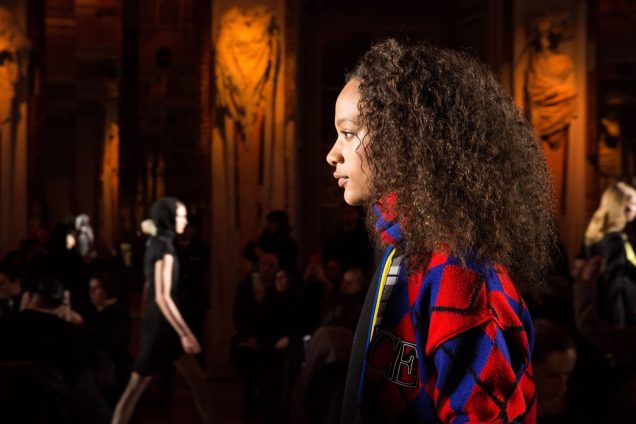This post has been updated.
It’s no secret that, when it comes to diversity on the runway, fashion month has a long way to go. Not that the industry hasn’t made visible progress. Case in point: on February 22, Sudanese model Anok Yai, who was raised in the United States after arriving as a refugee in 2000, became the first black model to open a Prada runway show in more than 20(!) years. (The last being Naomi Campbell in 1997.)
Still, models who don’t fit Prada’s erstwhile waifish, Lolita-esque standard remain the minority. The problem is not a lack of diverse talent for designers and casting directors to choose from. The problem is that only a handful of designers — most of them in New York — choose to practice inclusive casting season after season.
Thus, when our New York Fashion Week Fall 2018 Diversity Report revealed only minor improvements in the number of nonwhite and transgender or non-binary models and regressions on the plus-size and over-50 fronts, it did not bode well for the Fall 2018 season as a whole. Scroll to see how (and if) European designers tilted the scales.
RACE
During the Fall 2018 season, more women of color walked the runway than ever before. Out of 242 shows and 7,608 model appearances in New York, London, Milan and Paris, 32.5 percent of castings went to models of color, a 2.3 point increase from Spring 2018’s 30.2 percent. (Interestingly, that’s the exact same jump we saw between Fall 2017 — wherein 27.9 percent of models were women of color — and Spring 2018.) For comparison, when we first started keeping track of runway diversity back in Spring 2015 that number was only 17 percent.
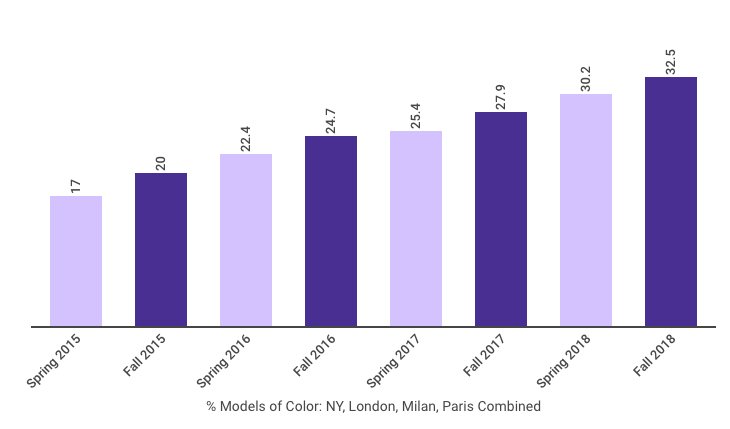
New York was, per usual, the most racially diverse of all four cities and, per usual, its 37.3 percent nonwhite runways helped raise the average significantly. Still, there were notable improvements overseas. For the third season running, London’s runways were the second most racially diverse. For Fall 2018, 34.6 percent of castings in London went to models of color, a 3.6 point increase over Spring 2018’s 31 percent and a 6.2 point increase over Fall 2017’s 28.4 percent.
In Paris, the Fall 2018 runways were 31.1 percent nonwhite, a 4.1 point increase over Spring 2018’s 27 percent and a 5.2 point increase over Fall 2017’s 25.9 percent. This is the first time that nonwhite models have accounted for over 30 percent of Parisian castings.
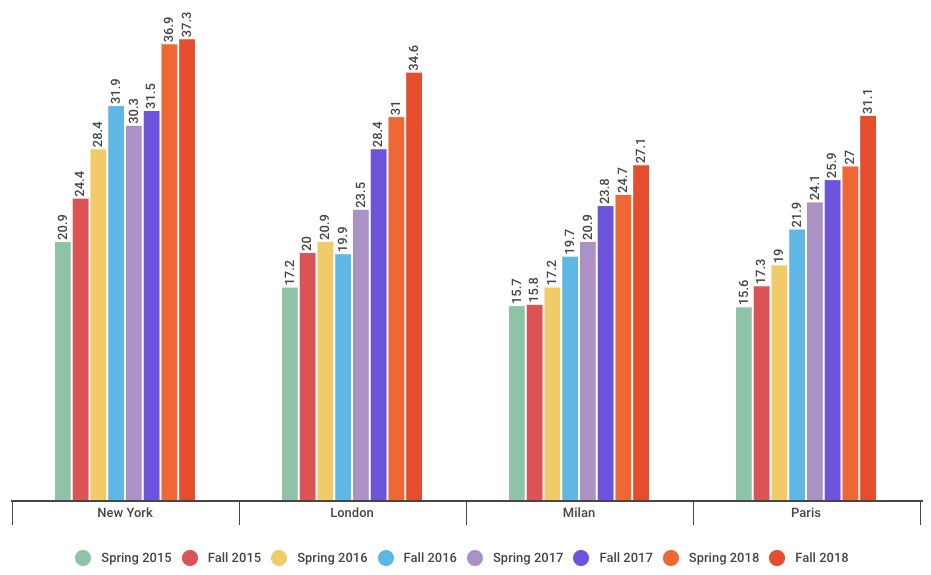
In Milan, which consistently falls behind the other fashion capitals in terms of inclusion, the runways were 27.1 percent nonwhite, compared to Spring 2018’s 24.7 percent (a 2.4 point difference) and Fall 2017’s 23.8 percent (a 3.3 point difference). Still, here’s some happy news: the number of models of color cast in Milan finally exceeded 25 percent. For comparison, both London and Paris hit this benchmark a year ago during the Fall 2017 season. Nevertheless, it’s a step in the right direction. It’s also encouraging that the number of nonwhite model castings in Milan, London and Paris has now been on an upward trend since Fall 2016. (New York’s numbers dipped between Fall 2016 and Spring 2017.)
PLUS-SIZE
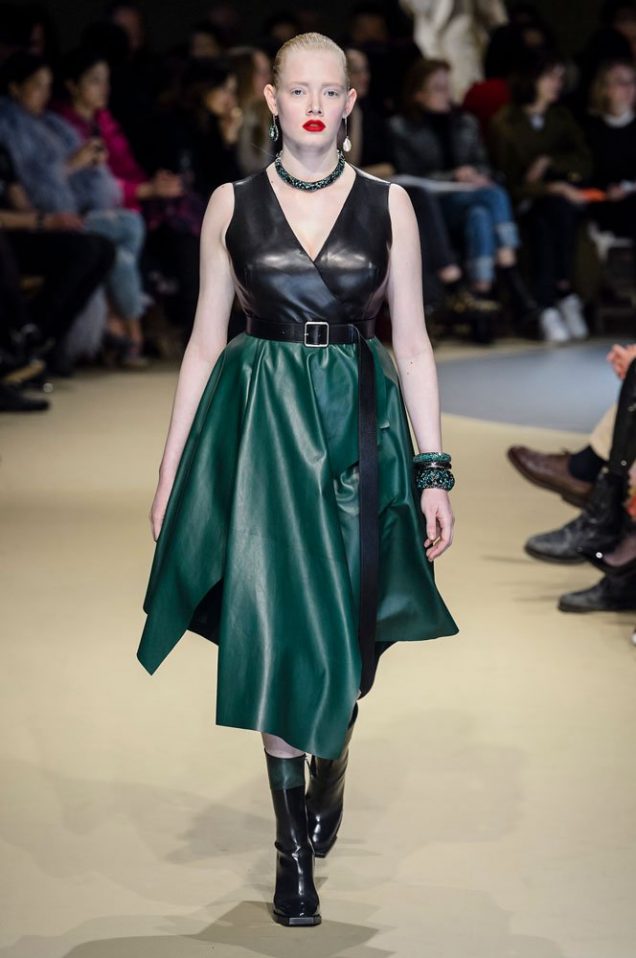
Last season, the number of curve model castings reached an all-time high with 38 plus-size models appearing across 12 runways (or 93 models across 14 runways, if you count the models cast by plus-specific retailers Torrid and Addition Elle, which, for the sake of consistency, we will not).
Conversely, for Fall 2018, we saw our first regression in plus-size castings since Fall 2016: a total of 30 plus-size models walked in all four cities this season. That’s eight castings shy of last season’s figure, but on par with Fall 2017. That said, if we look at the data in terms of percentage, the past three seasons are in a dead heat: Fall 2018’s 30 plus-size castings, Spring 2018’s 38 and Fall 2017’s 30 each made up close to 0.4 percent of the total castings in those respective seasons — proof that the category has seen little progress in years.
Moreover, while plus-size models regularly walk alongside straight-size models at the New York shows, Paris Fashion Week featured only three models in the category, London and Milan none. Note that since we first started keeping track of size inclusiveness on the runways in Spring 2016, Fall 2017 has been the only season in which any plus-size models walked in Milan and Spring 2018 was the first in which a London designer hired a non-straight-size model.
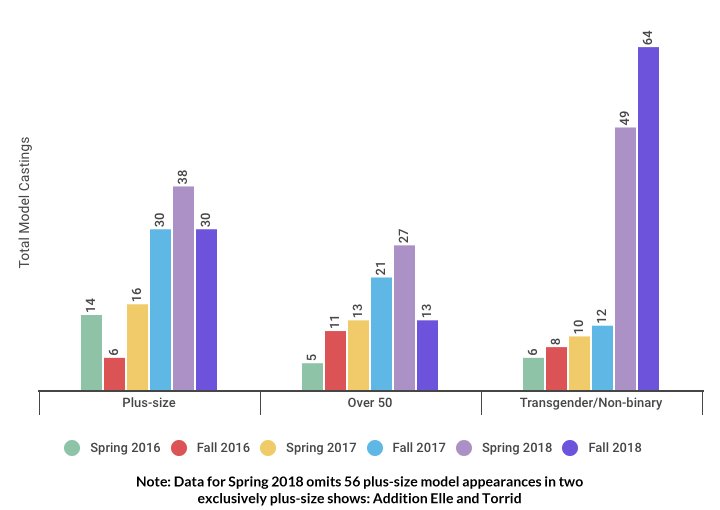
Per tradition, the majority (19) of the season’s plus-size model appearances were divided between two New York labels: Christian Siriano and Chromat. Siriano hired 10 plus-size models, including Ashley Graham, Candice Huffine, Danielle Brooks, Georgia Pratt, Marquita Pring, Precious Lee, Tara Lynn, Sabina Karlsson, Seynabou Cissé and Chloe Vero. Chromat’s Becca McCharen-Tran hired nine, including Karlsson, Denise Bidot, Ericka Hart, Priscilla Huggins Ortiz, Tash Ncube and Victoria Gomez. Additionally, Graham and Karlsson walked at Michael Kors, Prabal Gurung cast Graham and Paloma Elsesser walked for Eckhaus Latta for the second season running.
Across the pond, Dutch model Betsy Teske took her second turn on the Alexander McQueen runway (she made her catwalk debut at the brand’s Spring 2018 show). Elsewhere in the City of Light, social media sensation Naomi Shimada and West Indian model Gabrielle Richardson walked for H&M, another habitual body diversity advocate.
While the scarcity of plus-size models on the Fall 2018 runways was disappointing, one silver lining came from the fact that most (21) of the season’s curvy model castings went to women of color and that the remaining 9 (white) models included two women over age 50 (Emme and Mia Michaels at Chromat).
TRANSGENDER/NON-BINARY
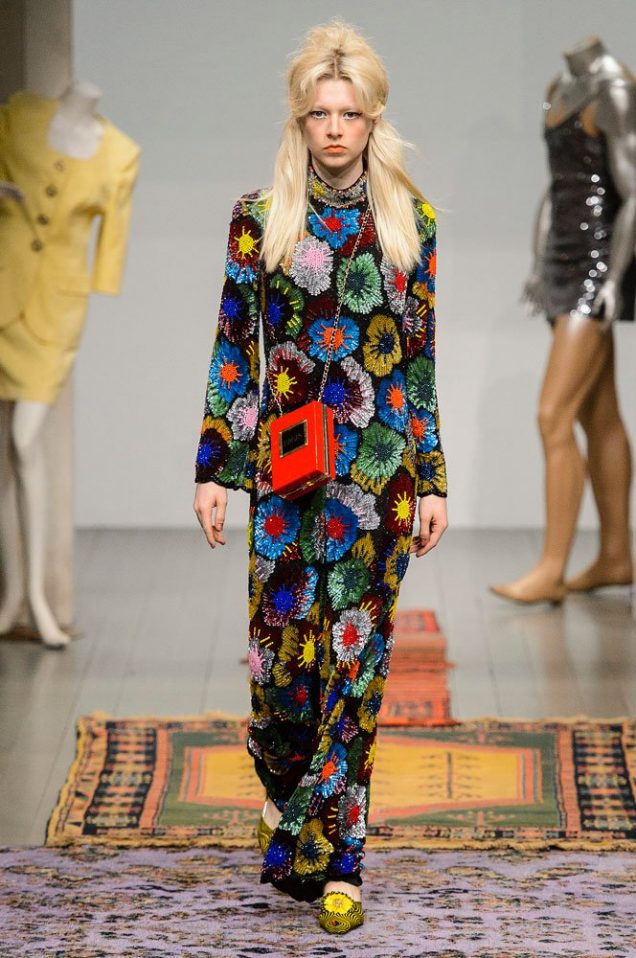
To call the Fall 2018 runways gender inclusive would be a stretch, but transgender and non-binary models did see a significant boost in visibility. As in our New York-centric report, this was the only category, apart from race, to see any sort of improvement.
A record 64 transgender women and non-binary models (56 transgender, 8 non-binary) walked in 52 shows, besting Spring 2018’s showing (45 transgender women, 4 non-binary models, 47 shows) by 15. For comparison, only 12 trans or non-binary models walked in 5 Fall 2017 shows — and that was just one year ago. When we first started tracking this figure back in Spring 2016, we counted only 6.
Moreover, the number of transgender and non-binary models on the runway increased in all but one of the four cities, the exception being Milan. New York saw 33 trans and non-binary model castings (up from 31 last season), London 10 (up from 1 last season, the biggest jump of any city), Paris 14 (up from 10 last season). Milan had only seven such castings, matching its Spring 2018 season.
We’d be remiss not to (once again) point out that Teddy Quinlivan’s September 2017 coming out greatly bolstered Spring 2018 and Fall 2018’s numbers for this category. Last season, the runway staple accounted for over half (27) of all transgender and non-binary castings, including all those that took place in Milan and all but one in Paris. For Fall 2018, Quinlivan was responsible for roughly 39 percent (25) of the trans and non-binary model appearances, including, again, all those in Milan and 9 of the 14 in Paris.
Still, it appears the industry is (slowly) moving beyond tokenism: between Spring 2018 and Fall 2018, the number of gender-inclusive, non-Quinlivan castings increased by 13.
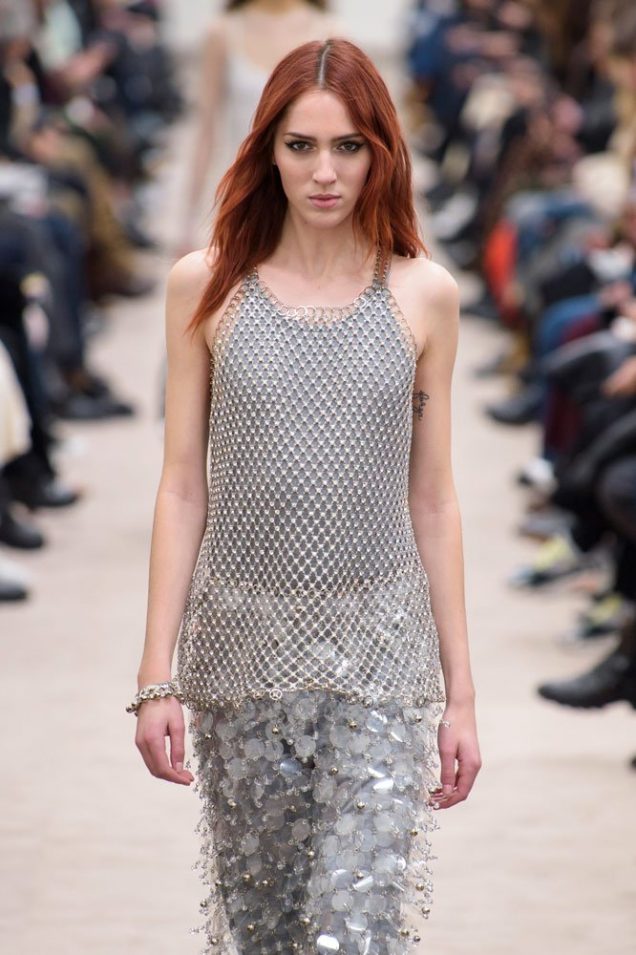
In London, Massima Lei walked for Fashion East, Halpern, Natasha Zinko and Matty Bovan; Hunter Schafer for Matty Bovan, House of Holland, Mother of Pearl and Ashish. Non-binary model Ziggy joined Schafer at Ashish; Benedict Douglas Stewardson made an appearance at Gareth Pugh. (Note that Christopher Bailey’s rainbow-splashed final Burberry collection, dedicated to the LGBTQ community, featured zero transgender women.) Paris’ non-Quinlivan sightings included Lei at DROMe and Unravel, Schafer at Miu Miu, Dara Allen at Kenzo and non-binary model Axelle Doué at Uma Wang.
Per usual, New York yielded the most racially diverse castings within the category. Ten of the city’s 33 gender-inclusive castings went to models of color (for the full breakdown, head to our preliminary Fall 2018 diversity report). One non-binary model of color (Ziggy) walked in London, one transgender woman of color (Allen) in Paris. Milan Fashion Week saw no transgender and non-binary models of color cast.
AGE
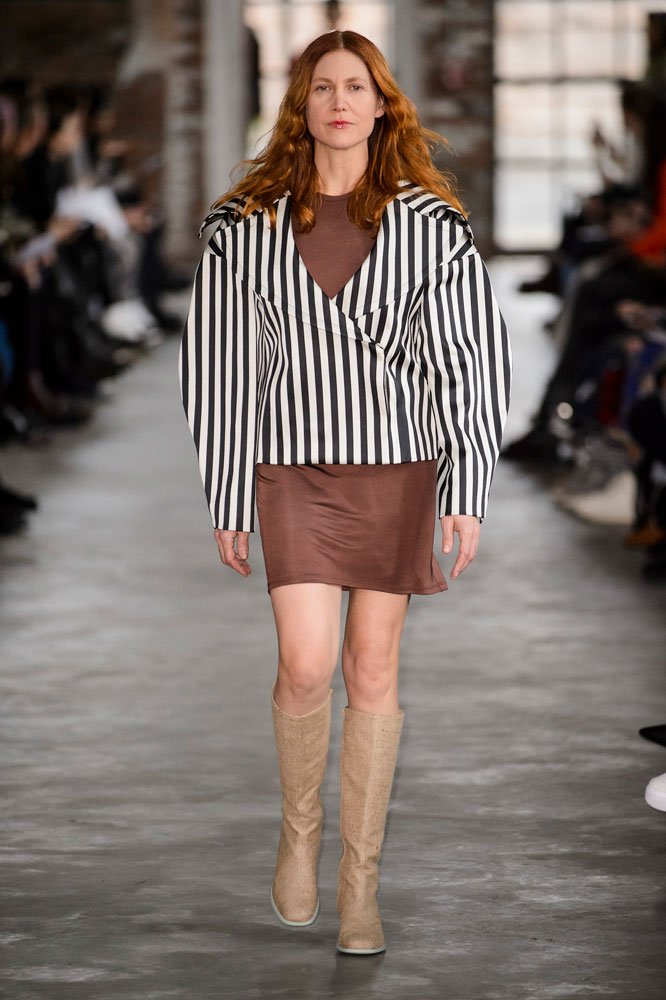
This season, women in their 50s, 60s and upward were not only the least represented category (as is typically the case), their numbers also suffered the steepest decline. For Fall 2018, only 0.2 percent of those on the runway were age 50 or above — in other words, 13 models. That’s the lowest number recorded since Spring 2017, which also saw 13 over-50 model castings and 14 fewer than in Spring 2018, the most age-diverse season on record.
Even with Tome, J.Crew, Opening Ceremony and Tracy Reese — which regularly prioritize age inclusivity — off its calendar, most (9) of the over-50 model appearances were in New York.
Eckhaus Latta hired two women over 50, including fashion designer and artist Susan Cianciolo, who regularly models for the brand. Stout heiress and style icon Daphne Guinness walked for The Blonds. Creatures of Comfort’s “celebration of womanhood” featured models of a wide range of ages, one of them over 50. Cecilia Chancellor turned up at The (notoriously exclusionary) Row. Plus-size supermodel Emme made her second Chromat appearance, fellow quinquagenarian and curve model Mia Michaels (of So You Think You Can Dance fame) her first. They were the only non-straight-size over-50 woman cast all month.
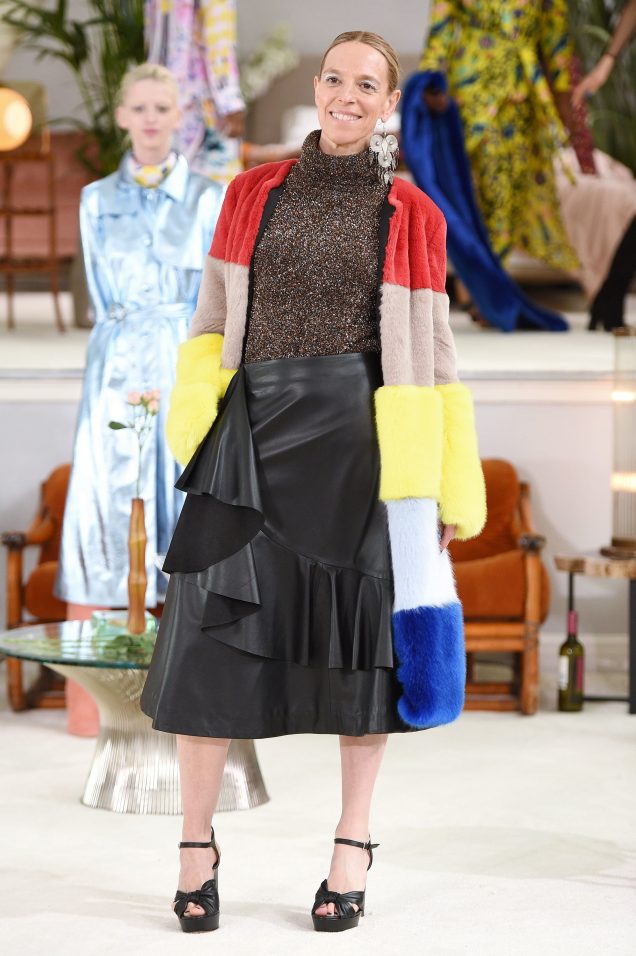
For the rest of fashion month, we saw only two over-50 models in London (down from three last season), two in Milan (down from seven last season) and zero in Paris (again, down from seven last season). It appears Spring 2018’s embrace of 90s and early-2000s supers was not a lasting trend, just a case of stunt casting. (Though 41-year-old John Galliano muse Debra Shaw did walk in Paris, at Uma Wang, and London, at Gareth Pugh.)
As for the European brands doing their part, Milan’s Arthur Arbesser and Daniela Gregis continue to champion age inclusivity within fashion. Cordula Reyer returned to Arbesser’s runway for the second season running; Benedetta Barzini did Gregis the same honor.
In London, Tiphaine de Lussy modeled a party-ready look — multicolor fur coat, ruffled leather skirt, gold-flecked Lurex sweater — by her pal Osman and Catherine Teatum and Rob Jones’ three “chapter” show featured one gray-haired model in a silky, cornflower-blue sundress.
Sadly, of the above-mentioned castings, none went to women of color or transgender models, whereas last season’s tally included four women of color and one transgender woman of color.
TOP MODELS
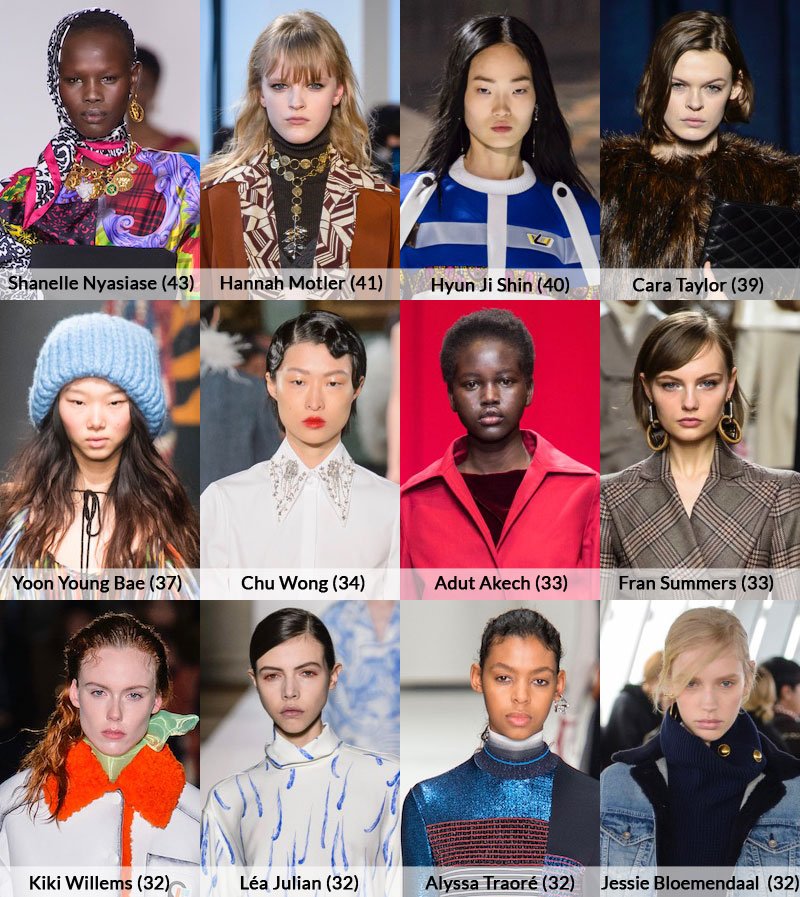
Of the 12 top models who racked up the most runway appearances this season, half were women of color: Shanelle Nyasiase (with 43 shows), Hyun Ji Shin (with 40), Yoon Young Bae (with 37), Chu Wong (with 34), Adut Akech (with 33) and Alyssa Traoré (with 32). What’s more, Fall 2018’s most in-demand model — Nyasiase — is of South Sudanese descent. And heartening as it is that a woman of color topped the list, no transgender, plus-size or mature models made the top 12. (Transgender model Teddy Quinlivan, who nabbed 25 castings, came the closest.)
MOST AND LEAST DIVERSE SHOWS
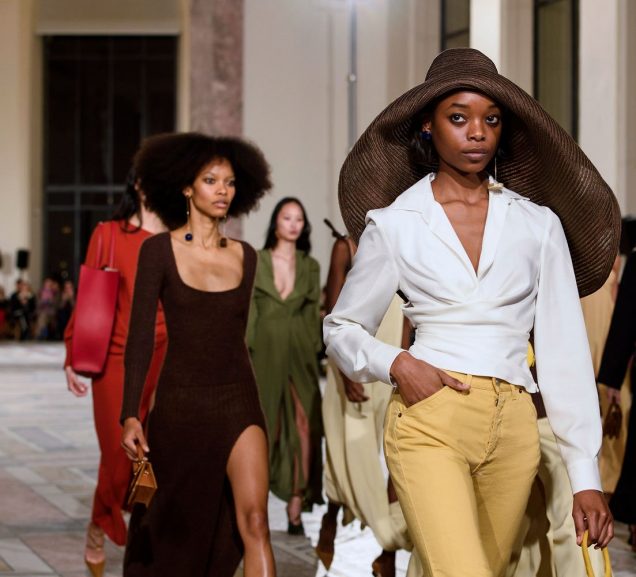
While the days of New York labels featuring zero nonwhite models are seemingly behind us, the days of European brands committing said offense are not. Two Milan-based brands, Les Copains and Daniela Gregis, inexcusably featured not a single model of color among casts of 23 and 12, respectively. (The fact that Gregis was one of the few European labels to hire a model over age 50 makes its entirely whitewashed lineup all the more puzzling.)
Several other brands also failed at adequate racial representation, though not quite as miserably. Also in Milan, Elisabetta Franchi, Piccione Piccione and Daizy Shely hired 1 out of 30 (3.3 percent), 1 out of 23 (4.4 percent) and 3 out of 37 (8.1 percent) nonwhite models, respectively. In London, Jasper Conran cast 3 out of 25 nonwhite models (12 percent); Delpozo only 4 out of 29 (13.8 percent). In Paris, Junya Watanabe and Undercover, two labels that have a bad habit of producing all-white shows, again missed the mark. Watanabe cast 1 out of 18 (5.6 percent) nonwhite models, Undercover 2 out of 32 (6.3 percent). Finally, New York was not without its offenders: Vivienne Hu, Jill Stuart, Zang Toi and Katie Gallagher only included 2 out of 18 (11.1 percent), 4 out of 29 (13.8 percent), 2 out of 14 (14.3 percent) and 2 out of 13 (15.4 percent) nonwhite models, respectively.
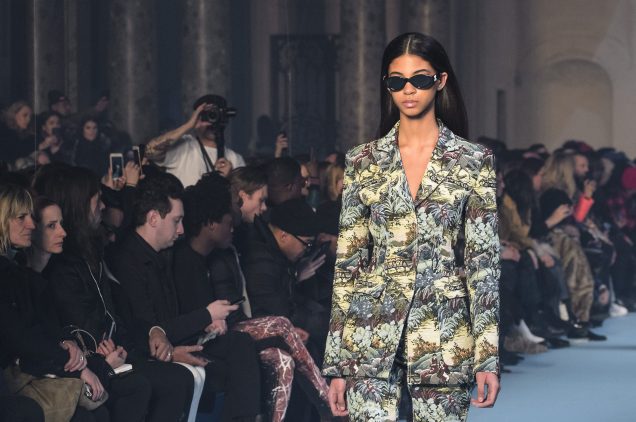
Even with several of its diversity tentpoles — Yeezy, Tome, Tracy Reese, J.Crew, Opening Ceremony, Kimora Lee Simmons, Helmut Lang under Isabella Burley — gone or on hiatus, New York still gave us four of the top five most racially diverse shows of Fall 2018: Gypsy Sport (80 percent models of color), Chromat (72.7 percent models of color), Matthew Adams Dolan (70.6 percent models of color), Jeremy Scott (70 percent models of color) and Brandon Maxwell (70 percent models of color). The only extra-New York show to make the list was London’s Ashish, which, with 79 percent models of color, was the second-most racially diverse show of the season.
Of course, the shows listed above were far from the only labels to embrace inclusive casting. Apart from Ashish, Gareth Pugh (67 percent models of color), Sophia Webster (63 percent models of color) and Osman (52 percent models of color) hired London’s most ethnically diverse casts.
In Milan, Vionnet cast 53 percent models of color, Antonio Berardi 56 percent, Missoni 63 percent. Meanwhile, the Parisian runways supported the oft-repeated hypothesis that edgy (young) designers are the ones truly embracing diversity — Kenzo (67 percent models of color), Jacquemus (63 percent models of color) and Off-White (59 percent models of color) had the week’s most racially diverse lineups.
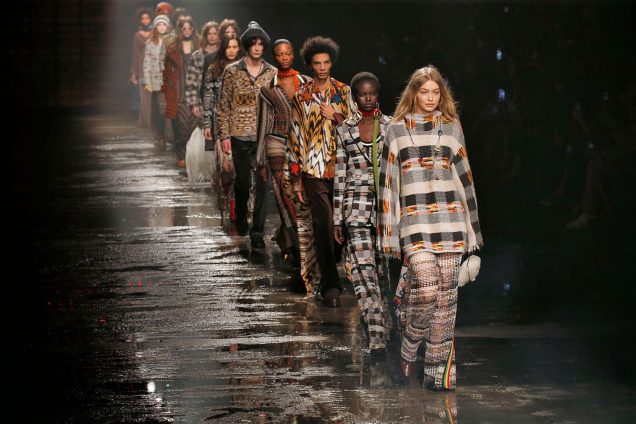
As for the labels that adopted a more comprehensive view of runway diversity — prioritizing not only race but also size, age, ability and/or gender identity — you’ll see a lot of the same names repeated. Again, New York designers — Christian Siriano, Marc Jacobs, Eckhaus Latta, Chromat and Gypsy Sport — rose to the top of the pile.
Siriano hired 44 percent women of color, two non-binary models and gave more runway spots to plus-size models than any other Fall 2018 designer. Thirty-seven percent of the models in Marc Jacobs’ body-swamping clothes were women of color; four were transgender. Chromat featured models of a wide breadth of ages, sizes and ethnicities, among them trans activists, breast cancer survivors and prosthesis-wearers. Eckhaus Latta’s 40 percent nonwhite runway was one of the few on which women over the age of 50, women above a size 8 and women not assigned female at birth all saw themselves represented. Gypsy Sport, known for its reliably inclusive casting, hired a slew of unconventional models, among them self-proclaimed “drag kid” Desmond Is Amazing.
A handful of European designers likewise challenged the status quo. Teatum Jones’ lineup featured 41 percent models of color along with one model over age 50. In addition to hiring mostly models of color, Gareth Pugh, Ashish, Missoni and Kenzo each cast at least one transgender or non-binary model. (Of course, Missoni’s choice was white, slender, cis-presenting Teddy Quinlivan, but progress is progress.)
That we’re able to call the Fall 2018 season the most racially diverse and gender-inclusive one yet — even in the absence of several diversity-championing designers — speaks to the fact that fashion’s narrow view of the ideal is, in some respects, changing, albeit very slowly. Of course, creeping, consistent change is preferable to great forward leaps that are ultimately unsustainable, like the ones we saw in Spring 2018.
And while a cynic might say that African and transgender models are simply Fall 2018’s flavor of the month, fashion’s way of capitalizing on popular public movements — what with Black Panther dominating box offices and Sarah McBride, transgender volleyball stars and President Trump’s proposed military ban dominating headlines — we suppose we’ll have to wait and see if the progress holds even after the PR buzz dies down.
Additional reporting by Mark E.
Only women and non-binary models are included in this data. Models of color are categorized as those who are nonwhite or of mixed backgrounds. Spring 2018 collections that showed during the Fall 2018 season are included in this report.
